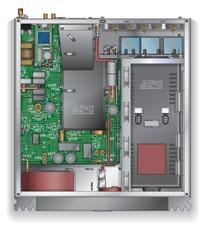Inner Workings: Inside a Surge Protector

| Click on the picture to see a description |
The most prominent feature on the S20''s face is a large vacuum- fluorescent readout, surrounded by an elliptical array of LEDs and buttons. The back panel includes two six-outlet banks (for a total of 12 outlets), arranged according to the type of filtering protection they provide (analog, digital, video, and high-current). There also are coaxial/RF and phone jacks (for hooking up phones, satellite receivers, and DVRs), Cat5 Ethernet and USB data ports, an RS-232 jack, and ports for connecting an external battery. A building-wiring fault indicator reveals house-wiring issues, such as reversed polarity or the lack of a ground wire. The S20 also has an Environmental port, which measures and records ambient temperature and humidity when used with an optional probe (a temperature-only probe is included) and automatically shuts down the equipment if preset temperature and humidity levels are exceeded.
Take a look inside the S20, and the first thing you''ll notice are the AC outlet banks, connected to the noise-filter banks. About a third of the chassis is taken up by a large battery pack. To the left of the battery is the inverter/charger, which converts the battery''s DC power to AC and keeps the battery charged. Behind that is the thermal-management system, for keeping the unit cool even when it''s running off the battery. To the side of this is the input-filter bank, which reduces noise, and the surge-protection circuitry, which protects connected gear from power surges.
APC AV uses a variety of components to filter and surge-protect, including metal-oxide varistors (MOVs, the most common form of surge protection), capacitors, inductors (also called chokes), and fuses. There''s also a resettable circuit breaker. Because the voltage surging through home AC lines fluctuates constantly, the S20 has a toroidal transformer (located near the front), which acts as a voltage regulator to maintain a constant supply of stable power.
At the risk of oversimplification, here''s how the S20 works. Electricity comes in through the AC power cord and goes through the input filters and the transformer before being sent to the output-filter banks and output receptacles. The transformer feeds power to the inverter/charger circuit, and if the current falls out of a prescribed range - like when a large household appliance kicks in - or if power fails completely, the unit disconnects from your utility''s grid power and switches to the backup battery. This happens so quickly that the power transfer is virtually unnoticeable.
One intriguing feature of the S20 is its extensive capability of being monitored and managed remotely, enabling installers to check on and control it from home-automation-network touchpanels or even over the Internet (thanks to its networking card). This lets them restore settings or even reboot "hung" equipment via the Web, saving customers a potentially costly service call. While some might balk at the S20''s four-digit price tag, try doing that with a $25 strip-style surge protector.























































